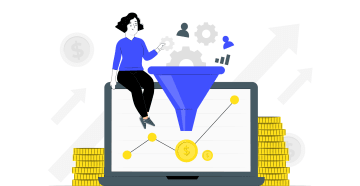Guides & best practices
View all articlesFunnel Design: A guide to getting your funnel right

Companies that fail to land a sale are often left in the dark about what went wrong. Where in the entire customer journey process did things sour? Where did they miss the mark?
The answer often lies in the construction of a marketing and sales funnel. For companies who don’t prioritize a funnel design, the chances for a future missed sale increase drastically.
There are so many opportunities that come with focusing on building a better funnel design. We’re going to show you how.
What is a lead funnel?
A sales or lead funnel highlights each step of the customer journey. It is a blueprint that reveals which stage of a journey a potential customer might be on during the buying process.
A funnel is broken down into three stages, the top, middle, and bottom of the funnel. The top of the funnel involves marketing campaigns that bring visitors to your company website. The middle of the funnel is when a visitor is learning more about your product or service before making a purchase. And the bottom of the funnel is when a purchase happens.

Why do you need a strong funnel?
A funnel gives powerful insight into what a potential customer might be experiencing as they navigate the buying process. With this insight comes important information that shows where sales are going right (or wrong). You’ll then be able to tweak your system to fix any problem areas.
How to craft an amazing funnel
Creating a great funnel is a multi-step process that requires continuous updating, testing, and analysis. Here are the best ways to make sure you create an amazing funnel that works for you.
Understand visitor behavior
Your target audience is the key to funnel success, so prioritize learning about them and trying to understand their behavior. What are their desires and needs? What are they specifically looking for? Where are they from? What kind of messaging will connect with them?
Answering these questions will get you in-sync with potential customers and you’ll be able to deliver a better experience to them as a result.
Update your landing pages
Keep your potential customer top-of-mind when you’re reworking landing pages. What are they looking for, and does the page offer answers? Does the CTA metaphorically jump out at a visitor, or does it miss the mark? Rework it based on brand voice and target audience. Keep the voice consistent when considering the path a user will take from their first point of contact with your company (blog post, website advertisement, etc.) to the landing page.
Also, ensure your page speed is optimized. It’s a proven fact that a slow loading page reduces the amount of conversions. Keep your speeds up across all points of connection, including from mobile devices.
Deconstruct and analyze your funnel
One of the most important and underutilized way to improve a funnel is to analyze it at each stage. Consider how things like content are performing. How effective are your latest marketing campaigns? Is your business growing due to word-of-mouth? If not, why not? How can you make this a more likely outcome?
These types of analyses can lead to a better understanding of how well your funnel is performing. When broken down stage-by-stage, the picture becomes much clearer.
Prioritize customer relationships
Communication is crucial when fostering a company-customer relationship. When a visitor becomes a customer, prioritize further communication and engagement with them to inform them about your service, future plans, and any updates. If possible, follow up with them to learn more about what worked with them throughout their own customer journey.
If the visitor doesn’t become a customer, use it as a learning experience in terms of what worked and what didn’t. But also, have a system in place to follow up with them to try to close a sale until it’s clear they’re no longer responsive.
Use funnel builder software
Funnel builder software maximizes the path to building professional funnel designs via filtered lead analysis. The right funnel builder tool helps you evaluate and improve your sales pipeline.
A good funnel builder software system should provide the following benefits:
Higher ROI due to more quality leads and sales
Better customer satisfaction and reportedly superior customer experiences
Increased data analyses and insights
Advanced automation to streamline processes
Higher quality lead management
Heyflow’s funnel builder software makes it easy for marketing teams to steer their funnel design toward more successful outcomes. Heyflow integrates with your current tools for a seamless ramp up process, allowing you to engage and nurture your leads through each step of the funnel.
Here are a few of the benefits to using Heyflow’s funnel builder:
Endless customization possibilities
Built for efficiency while staying easy-to-use
Automation, including automated responses, that saves teams time
No-code system with a simple drag-and-drop tool pagebuilder
Comprehensive analytics to shed light on important aspects of your funnel
Conclusion
Pinpointing the flaws and successes of a company’s overarching sales process and customer journey really does lead to an examination of a funnel design. Make sure that you use the above tips to streamline your funnel.



